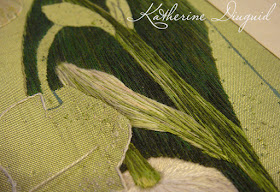So, I have accepted that I will be redoing this module. As I finished this bit, I kept trying to think of all the positives of needing to do the module twice. The main one I came up with was practice. I will be thankful for it in the end I'm sure. The thing that makes me the most nervous about this silk shading is that you are looking at the same bit for so long that I start to really to see all the weirdnesses and I really start to second guess myself. It kind of all starts to look the same and blend together and I start freaking out that it's just not right.
Anyways, I thought it might be good to just talk about the struggles I've had with this bit. The first struggle I had was getting the curvature on the tip right. I know this sounds easy, but it is a very small sized area and getting it just right was difficult to me. After a few tries though, I think it did improve. Next, I'm not sure if maybe my stitches were too long, but I had trouble keeping the smoothness as I moved around the bend towards the bottom. What I cannot figure out is if the stitching towards the base is stringy looking and overworked or if it's just the stripy quality of the colors. I needed a darker green, but I feel that the darker green that I used (which was the best of the bunch of my DMC's) is too dark and is too much contrast.
I am trying though and learning. I think my biggest struggle is actually working by myself on this. There is something comforting when you work with a group of ladies that are all learning together. Thinking of all the fun times over the past few years with the many different women that I've had the opportunity to stitch with . . .








I think having a wider range of colors to pull from will help the transitions. I usually do this with paint, and when I transition from light to dark, I like to do a wet blend so the colors mix a bit at the intersecting areas. It gives a more natural flow to the piece as it travels from light to dark. However if you are working from an inspiration of contrasting colors and stronger lighting, you can carry on with the high contrast values.
ReplyDeleteHi Britt,
DeleteDo you paint the under fabric or the actual thread? I have seen where some people paint the whole area to be stitched on the fabric to guide their shading.
I will say that on the photo it is stripy looking. I had been wanted a more blended look, but then it didn't look like part of the same flower and felt disjointed to the stem, so I added that darker color. This is one of those times when I wished I had done little squares of this section done with a couple different color combinations to see which I liked better.
I apologize if you get multiple comments. The iPad was fighting me on the publish step.
DeleteI haven't painted textiles aside from a few theatrical drops and soft covered flats. I was thinking more about color mixing theory in my reply.
You probably could paint each thread, but that sounds really intensive. I wonder if you couldn't split some of your thread and ply the lighter and darker parts together. Similar to plying different colored singles in hand spinning.